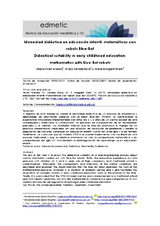Idoneidad didáctica en educación infantil: matemáticas con robots Blue-Bot
Didactical suitability in early childhood education: mathematics with Blue-Bot robots
Autor
Ricart Aranda, María
Estrada Roca, María
Margalef Martí, María
Editor
UCOPressFecha
2019Materia
Educación preescolarRobótica
Geometría
Evaluación
Pre-school education
Robotics
Geometry
Assessment
METS:
Mostrar el registro METSPREMIS:
Mostrar el registro PREMISMetadatos
Mostrar el registro completo del ítemResumen
El objetivo de este trabajo es valorar la idoneidad didáctica de un proceso de enseñanza y aprendizaje de orientación espacial con el robot Blue-Bot. Primero, se contextualiza la experiencia innovadora implementada con niños de 5 y 6 años de un centro escolar de alta complejidad y tradicional; a continuación, se describen las componentes de las idoneidades parciales y se valoran. Los resultados indican que la Blue-Bot promueve el trabajo de los procesos matemáticos implicados en una situación de resolución de problemas y facilita la adquisición de nociones complejas en educación infantil, como son la de giro y la de tiempo. Finalmente, se concluye que el modelo STEAM se puede implementar con facilidad en una escuela tradicional y que la robótica promueve no solo la competencia matemática y las competencias del siglo XXI, sino también la autorregulación del aprendizaje ya en educación infantil. The aim of this work is to assess the didactical suitability of a teaching-learning process about spatial orientation carried out with Blue-Bot robots. Firstly, the innovative experience put into practice with children of 5 and 6 years old of high complexity and traditional school is contextualized. Afterwards, the components and indicators of the partial suitabilities are described and assessed. The results indicate that the Blue-Bot robot promotes the work of the mathematical processes involved in a situation of problem solving and it also facilitates the acquisition of complex notions in early childhood education, such as the rotation or the time. Finally, it is concluded that the STEAM model can be easily implemented in a traditional school and that robotics promotes not only the mathematical competence and competences of 21st century, but also de self-regulation of learning in early childhood education.

